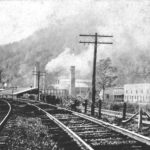Alice Fuchs

Alice Fuchs was a distinguished aviator who became the first female instructor of cadets at the Air Force Academy. The Penn State graduate trained countless new pilots and was a well-known author on aviation subjects.


Alice Fuchs was a distinguished aviator who became the first female instructor of cadets at the Air Force Academy. The Penn State graduate trained countless new pilots and was a well-known author on aviation subjects.

The manufacture of refractories – brick capable of withstanding extremely high temperatures – was one of Centre County’s major industries for more than seventy years. By the early 20th century, about 800 workers at eight brickyards were producing what was commonly known as fire brick.

Big Spring is a natural groundwater outlet found in Talleyrand Park in downtown Bellefonte, noteworthy for both its unique geology and its historical significance.The powerful spring forms a pool at the edge of the park.

James Irvin was the ironmaster of Centre Furnace and the benefactor whose gift of 200 acres led to the establishment in Centre County of the Farmers’ High School of Pennsylvania, the future Penn State University.

The Bush House was a four-story hotel situated along Spring Creek in downtown Bellefonte built by Daniel G. Bush. Before it was destroyed by fire in 2006, it was a contributing property in the Bellefonte National Historic District.
Robert Cole was a self-trained architect who designed some of Bellefonte’s best-known buildings, as well as churches, homes and other structures in Centre County.

Limestone has played an essential role in Centre County’s economic history. Widely used for both industrial and agricultural purposes, limestone has been mined in the county for more than 200 years.

College Heights Service Station in State College is the oldest continuously operating service station in Centre County. The distinctive station was built by John N. and G. Dewey Krumrine on land that had been part of the Krumrine family farm in what is now the College Heights neighborhood.

John Patton was a Revolutionary War veteran and prosperous Philadelphia merchant and civic leader, who moved to Centre County in 1789 to build the region’s first charcoal-fired iron furnace, Centre Furnace. The operation’s success sparked the founding of additional furnaces and forges in what would become Centre County.

A pressing need to transport freight and people led to the building of Centre County’s only canal by the Bald Eagle and Spring Creek Navigation Company.